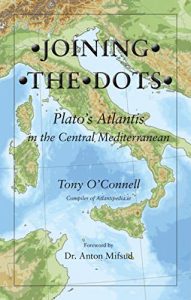Austin, Nick
Nick Austin is the author of Atlantis: The Minoan Truth [1661], in which he endeavours to give support to the idea of a Cretan location for Atlantis. The text of a second edition (dated 1/10/19) was available as a pdf file on the Academia.edu website(c), which is now offline.
>The most revealing thing to be found in this book are written in the first lines of the Introduction – “This book provides the historical and archaeological proof of the capital island city of Atlantis, which was created on the island of Crete, some time prior to 1900 BC. This evidence was delivered to me in October 2018 in the form of a Divine Revelation.” After that, for me, it was downhill all the way.<
The first part centres on the author’s chance encounter with what appear to be the remains of structures on the coast at Malia on the northern coast of Crete. Austin claims these as the remains of a Minoan Palace, which was destroyed by a megatsunami generated by the eruption of Thera (Santorini). While this may have been possible it does not make it the site of Atlantis. There are the remains of an excavated Minoan palace nearby(a).
There was one point on which Austin and I agree, which is the identification of the Strait of Messina as the most likely location of the Pillars of Herakles referred to by Plato [p217]. But it is on this very point that Austin’s theory collapses. If the Atlanteans attacked Athens from beyond the ‘Pillars’, that attack came from beyond (further than) the Strait of Messina. Crete, you will note, is situated in the other direction.
Unfortunately, Austin’s mistakes do not end there; he places Krakatoa in the Philippines [p178] , instead of Indonesia. He also thinks ‘Potamos’ means ‘middle’, whereas it is commonly known that in the word ‘Mesopotamia’, ‘meso’ means middle and ‘potamia. means ‘rivers’ (b). Enough.
(a) https://www.minoancrete.com/malia.htm
(b) https://en.m.wikipedia.org/wiki/Mesopotamia
(c) https://www.academia.edu/40326075/Atlantis_the_Minoan_Truth (now offline)
